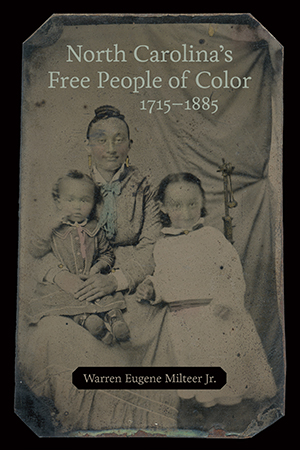
304 pages / 6.00 x 9.00 inches / 17 halftones, 1 map
African-American Studies | History / United States - Southern History | History / African American | Social Studies / Slavery Studies
In North Carolina’s Free People of Color, 1715–1885, Warren Eugene Milteer Jr. examines the lives of free persons categorized by their communities as “negroes,” “mulattoes,” “mustees,” “Indians,” “mixed-bloods,” or simply “free people of color.” From the colonial period through Reconstruction, lawmakers passed legislation that curbed the rights and privileges of these non-enslaved residents, from prohibiting their testimony against whites to barring them from the ballot box. While such laws suggest that most white North Carolinians desired to limit the freedoms and civil liberties enjoyed by free people of color, Milteer reveals that the two groups often interacted—praying together, working the same land, and occasionally sharing households and starting families. Some free people of color also rose to prominence in their communities, becoming successful businesspeople and winning the respect of their white neighbors.
Milteer’s innovative study moves beyond depictions of the American South as a region controlled by a strict racial hierarchy. He contends that although North Carolinians frequently sorted themselves into races imbued with legal and social entitlements—with whites placing themselves above persons of color—those efforts regularly clashed with their concurrent recognition of class, gender, kinship, and occupational distinctions. Whites often determined the position of free nonwhites by designating them as either valuable or expendable members of society. In early North Carolina, free people of color of certain statuses enjoyed access to institutions unavailable even to some whites. Prior to 1835, for instance, some free men of color possessed the right to vote while the law disenfranchised all women, white and nonwhite included.
North Carolina’s Free People of Color, 1715–1885 demonstrates that conceptions of race were complex and fluid, defying easy characterization. Despite the reductive labels often assigned to them by whites, free people of color in the state emerged from an array of backgrounds, lived widely varied lives, and created distinct cultures—all of which, Milteer suggests, allowed them to adjust to and counter ever-evolving forms of racial discrimination.
Warren Eugene Milteer Jr. is assistant professor of history at the University of North Carolina at Greensboro.
“In a remarkable feat of historical research, Warren Eugene Milteer, Jr. leads us on a compelling tour of a land where free people of color made the most of the limited but meaningful freedoms that slaveholding society afforded them. He introduces us to memorable, resilient people who regularly interacted with their white neighbors in ways that blurred racial categories.”—Melvin P. Ely, author of Israel on the Appomattox: A Southern Experiment in Black Freedom from the 1790s Through the Civil War
“Milteer’s premise is that free status was a more important attribute than race. He argues that throughout the period before 1865, ‘the legal position of free people of color generally remained closer to that of whites than to that of slaves.’ . . . Milteer depicts racial identity as fluid and contingent. He provides numerous examples of individuals and families who, over time were alternately described, or defined themselves, as Black, mulatto, Indian, or (more rarely) white, as their neighbors and circumstances.”—Journal of American History
Found an Error? Tell us about it.